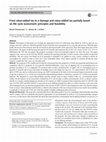Papers by Benoit Timmermans

Intertax, 2021
This article aims to examine how the implementation of environmental taxes could build on the suc... more This article aims to examine how the implementation of environmental taxes could build on the success of value-added tax (VAT) to become more efficient and consistent. This is not to increase the overall tax burden on citizens but to reorganize existing indirect taxation differently by better taking into account European Union (EU) environmental objectives, in particular regarding the circular economy. With its broad tax base, its systemic structure based on neutrality (which does not exclude differentiation), its wide acceptance among taxpayers, and its proven compliance process, the VAT has some features that could inspire environmental policymakers. It indeed impacts consumer choices at the broadest possible level while avoiding distortions. The authors begin by identifying the reasons for the success and robustness of VAT. A new concept of ‘green VAT’ will then be proposed based not on the classical instrument of reduced rates for specific transactions as is already done and adv...

Intertax : international tax review, Vol. 49, no. 11, p. 871-884, 2021
This article aims to examine how the implementation of environmental taxes could build on the suc... more This article aims to examine how the implementation of environmental taxes could build on the success of value-added tax (VAT) to become more efficient and consistent. This is not to increase the overall tax burden on citizens but to reorganize existing indirect taxation differently by better taking into account European Union (EU) environmental objectives, in particular regarding the circular economy. With its broad tax base, its systemic structure based on neutrality (which does not exclude differentiation), its wide acceptance among taxpayers, and its proven compliance process, the VAT has some features that could inspire environmental policymakers. It indeed impacts consumer choices at the broadest possible level while avoiding distortions.
The authors begin by identifying the reasons for the success and robustness of VAT. A new concept of ‘green VAT’ will then be proposed based not on the classical instrument of reduced rates for specific transactions as is already done and advocated by EU institutions (European Commission, Communication from the Commission to the European Parliament, the Council, the European Economic and Social Committee and the Committee of the Regions, A new Circular Economy Action Plan. For a cleaner and more competitive Europe, COM(2020) 98 final (11 Mar. 2020). See also Opinion of the European Committee of the Regions – New Circular Economy Action Plan (2020/C 440/18), OJ C 440/107 (18 Dec. 2020), para. 23.) but on a coherent life cycle approach to all goods and services. This new approach identifies negative externalities by following the same value chain as the VAT. It aligns as much as possible with the administration and compliance methods already implemented by the VAT.
Finally, a possible virtual use of the new green VAT concept will be presented. It does not require any legislative changes. It takes the form of a ‘virtual tax’ that appears on the price tag of every product without being effectively paid and may be used as an indicator for the actual environmental cost of production.

The International Journal of Life Cycle Assessment, 2018
Purpose The purpose of this article is to examine the arguments in favor of a shift from value-ad... more Purpose The purpose of this article is to examine the arguments in favor of a shift from value-added tax (VAT) or sales tax to a damage and value-added tax (DaVAT) partially based on the life cycle assessment (LCA) of goods and services. With this shift, goods and services that seriously harm the environment and human health will be priced up, those that impact them less will be priced down. The paper recalls the proposal made by De Camillis and Goralczyk (Int J Life Cycle Assess 18:263-272, 2013) to differentiate the VAT rate associated with products according to their environmental impacts over their life cycle. The paper suggests a new way to convert VAT into DaVAT, examines the operating principles of such a system, and considers its practical feasibility. The new policy tool based on LCA presented is intended to be applied to every country wishing to reform its consumption tax system in order to strive for a more sustainable future. Some aspects specific to countries having the same currency, notably the Euro zone, are also discussed. Methods The proposal of De Camillis and Goralczyk is discussed from the perspective of both environmental performance and compliance with LCA standards. To overcome the identified difficulties, a new way of adapting VAT (or consumption taxes in general) according to LCA is suggested. The proposal relies on three essential points: (i) apply VAT (or consumption taxes in general) to all goods and services and reduce its multiple rates to one single low rate (e.g., 3%) called uniform VAT (UVAT); (ii) add to UVAT a per-unit tax called global damage tax (GDT) calculated on the basis of environmental impacts assessed by means of specific or generic LCAs. In the case of potentially high-polluting products or industries, a specific LCA will be automatically imposed. The obligation to assess high-polluting activities already exists in many countries with, e.g., environmental impact studies, but the impacts are not necessarily evaluated by LCA; (iii) in order to reflect environmental, social, or ethical concerns specific to a country, another damage tax termed specific damage tax (SDT) is proposed that extends beyond LCA. DaVAT is the sum of UVAT, GDT, and SDT. DaVAT is conceived not as an additional burden but rather as a shift of taxation, as the rate of the old consumption taxes can decrease proportionally to the increase of GDT. DaVAT is also designed in such a way that the erosion of tax revenues, when pollutant would decline, is offset by the extension of the tax to all goods and services and by the possibility to gradually re-increase the UVAT rate when the number of highly polluting products decreases. Results and discussion The proposal is examined first from a theoretical point of view by considering which principles should be used to comply with LCA standards and general requirements of (environmental) tax policies. Four general principles emerge: consistency in the choice of the functional unit and in the characterization, normalization and weighting methods, transparency of information about the environmental score of the product, evolution capacity of the levers of the tax and of the assessment methods, respect for national sovereignty concerning the setting of the tax price. The proposal is also examined from a practical point of view by asking how the DaVAT system would work in practice. The answer takes into account associated costs, risks of fraud, price changes, and acceptability of the proposal. The issue about price changes is addressed on the basis of a simulation drawn from six published LCA studies on different products. Conclusions The proposal to replace most of the VAT or sales tax with a unitary global damage tax based on LCA of goods and services seems to meet expectations not only in terms of
Quel prix devrais-je payer en plus pour ce produit si le monde allait danParu dans Des valeurs en monde académique. Critique, imagination, interdépendance, sous la direction d’Edwin Zaccai, Académie Royale de Belgique, 2021
The aim of this paper is twofold. Firstly, to recall some of the difficulties encountered in inte... more The aim of this paper is twofold. Firstly, to recall some of the difficulties encountered in internalizing negative externalities. Secondly, to outline the plan for a tool which, despite the difficulties, would assess the negative impacts of products on the environment, health, and resources to adjust their price upwards or downwards.

International Journal of Life Cycle Assessment, 2018
Purpose
The purpose of this article is to examine the arguments in favor of a shift from value-a... more Purpose
The purpose of this article is to examine the arguments in favor of a shift from value-added tax (VAT) or sales tax to a damage and value-added tax (DaVAT) partially based on the life cycle assessment (LCA) of goods and services. With this shift, goods and services that seriously harm the environment and human health will be priced up, those that impact them less will be priced down. The paper recalls the proposal made by De Camillis and Goralczyk (Int J Life Cycle Assess 18:263-272, 2013) to differentiate the VAT rate associated with products according to their environmental impacts over their life cycle. The paper suggests a new way to convert VAT into DaVAT, examines the operating principles of such a system, and considers its practical feasibility. The new policy tool based on LCA presented is intended to be applied to every country wishing to reform its consumption tax system in order to strive for a more sustainable future. Some aspects specific to countries having the same currency, notably the Euro zone, are also discussed.
Methods
The proposal of De Camillis and Goralczyk is discussed from the perspective of both environmental performance and compliance with LCA standards. To overcome the identified difficulties, a new way of adapting VAT (or consumption taxes in general) according to LCA is suggested. The proposal relies on three essential points: (i) apply VAT (or consumption taxes in general) to all goods and services and reduce its multiple rates to one single low rate (e.g., 3%) called uniform VAT (UVAT); (ii) add to UVAT a per-unit tax called global damage tax (GDT) calculated on the basis of environmental impacts assessed by means of specific or generic LCAs. In the case of potentially high-polluting products or industries, a specific LCA will be automatically imposed. The obligation to assess high-polluting activities already exists in many countries with, e.g., environmental impact studies, but the impacts are not necessarily evaluated by LCA; (iii) in order to reflect environmental, social, or ethical concerns specific to a country, another damage tax termed specific damage tax (SDT) is proposed that extends beyond LCA. DaVAT is the sum of UVAT, GDT, and SDT. DaVAT is conceived not as an additional burden but rather as a shift of taxation, as the rate of the old consumption taxes can decrease proportionally to the increase of GDT. DaVAT is also designed in such a way that the erosion of tax revenues, when pollutant would decline, is offset by the extension of the tax to all goods and services and by the possibility to gradually re-increase the UVAT rate when the number of highly polluting products decreases. Results and discussion The proposal is examined first from a theoretical point of view by considering which principles should be used to comply with LCA standards and general requirements of (environmental) tax policies. Four general principles emerge: consistency in the choice of the functional unit and in the characterization, normalization and weighting methods, transparency of information about the environmental score of the product, evolution capacity of the levers of the tax and of the assessment methods, respect for national sovereignty concerning the setting of the tax price. The proposal is also examined from a practical point of view by asking how the DaVAT system would work in practice. The answer takes into account associated costs, risks of fraud, price changes, and acceptability of the proposal. The issue about price changes is addressed on the basis of a simulation drawn from six published LCA studies on different products.
Journal of The History of Ideas, 1999











Uploads
Papers by Benoit Timmermans
The authors begin by identifying the reasons for the success and robustness of VAT. A new concept of ‘green VAT’ will then be proposed based not on the classical instrument of reduced rates for specific transactions as is already done and advocated by EU institutions (European Commission, Communication from the Commission to the European Parliament, the Council, the European Economic and Social Committee and the Committee of the Regions, A new Circular Economy Action Plan. For a cleaner and more competitive Europe, COM(2020) 98 final (11 Mar. 2020). See also Opinion of the European Committee of the Regions – New Circular Economy Action Plan (2020/C 440/18), OJ C 440/107 (18 Dec. 2020), para. 23.) but on a coherent life cycle approach to all goods and services. This new approach identifies negative externalities by following the same value chain as the VAT. It aligns as much as possible with the administration and compliance methods already implemented by the VAT.
Finally, a possible virtual use of the new green VAT concept will be presented. It does not require any legislative changes. It takes the form of a ‘virtual tax’ that appears on the price tag of every product without being effectively paid and may be used as an indicator for the actual environmental cost of production.
The purpose of this article is to examine the arguments in favor of a shift from value-added tax (VAT) or sales tax to a damage and value-added tax (DaVAT) partially based on the life cycle assessment (LCA) of goods and services. With this shift, goods and services that seriously harm the environment and human health will be priced up, those that impact them less will be priced down. The paper recalls the proposal made by De Camillis and Goralczyk (Int J Life Cycle Assess 18:263-272, 2013) to differentiate the VAT rate associated with products according to their environmental impacts over their life cycle. The paper suggests a new way to convert VAT into DaVAT, examines the operating principles of such a system, and considers its practical feasibility. The new policy tool based on LCA presented is intended to be applied to every country wishing to reform its consumption tax system in order to strive for a more sustainable future. Some aspects specific to countries having the same currency, notably the Euro zone, are also discussed.
Methods
The proposal of De Camillis and Goralczyk is discussed from the perspective of both environmental performance and compliance with LCA standards. To overcome the identified difficulties, a new way of adapting VAT (or consumption taxes in general) according to LCA is suggested. The proposal relies on three essential points: (i) apply VAT (or consumption taxes in general) to all goods and services and reduce its multiple rates to one single low rate (e.g., 3%) called uniform VAT (UVAT); (ii) add to UVAT a per-unit tax called global damage tax (GDT) calculated on the basis of environmental impacts assessed by means of specific or generic LCAs. In the case of potentially high-polluting products or industries, a specific LCA will be automatically imposed. The obligation to assess high-polluting activities already exists in many countries with, e.g., environmental impact studies, but the impacts are not necessarily evaluated by LCA; (iii) in order to reflect environmental, social, or ethical concerns specific to a country, another damage tax termed specific damage tax (SDT) is proposed that extends beyond LCA. DaVAT is the sum of UVAT, GDT, and SDT. DaVAT is conceived not as an additional burden but rather as a shift of taxation, as the rate of the old consumption taxes can decrease proportionally to the increase of GDT. DaVAT is also designed in such a way that the erosion of tax revenues, when pollutant would decline, is offset by the extension of the tax to all goods and services and by the possibility to gradually re-increase the UVAT rate when the number of highly polluting products decreases. Results and discussion The proposal is examined first from a theoretical point of view by considering which principles should be used to comply with LCA standards and general requirements of (environmental) tax policies. Four general principles emerge: consistency in the choice of the functional unit and in the characterization, normalization and weighting methods, transparency of information about the environmental score of the product, evolution capacity of the levers of the tax and of the assessment methods, respect for national sovereignty concerning the setting of the tax price. The proposal is also examined from a practical point of view by asking how the DaVAT system would work in practice. The answer takes into account associated costs, risks of fraud, price changes, and acceptability of the proposal. The issue about price changes is addressed on the basis of a simulation drawn from six published LCA studies on different products.
The authors begin by identifying the reasons for the success and robustness of VAT. A new concept of ‘green VAT’ will then be proposed based not on the classical instrument of reduced rates for specific transactions as is already done and advocated by EU institutions (European Commission, Communication from the Commission to the European Parliament, the Council, the European Economic and Social Committee and the Committee of the Regions, A new Circular Economy Action Plan. For a cleaner and more competitive Europe, COM(2020) 98 final (11 Mar. 2020). See also Opinion of the European Committee of the Regions – New Circular Economy Action Plan (2020/C 440/18), OJ C 440/107 (18 Dec. 2020), para. 23.) but on a coherent life cycle approach to all goods and services. This new approach identifies negative externalities by following the same value chain as the VAT. It aligns as much as possible with the administration and compliance methods already implemented by the VAT.
Finally, a possible virtual use of the new green VAT concept will be presented. It does not require any legislative changes. It takes the form of a ‘virtual tax’ that appears on the price tag of every product without being effectively paid and may be used as an indicator for the actual environmental cost of production.
The purpose of this article is to examine the arguments in favor of a shift from value-added tax (VAT) or sales tax to a damage and value-added tax (DaVAT) partially based on the life cycle assessment (LCA) of goods and services. With this shift, goods and services that seriously harm the environment and human health will be priced up, those that impact them less will be priced down. The paper recalls the proposal made by De Camillis and Goralczyk (Int J Life Cycle Assess 18:263-272, 2013) to differentiate the VAT rate associated with products according to their environmental impacts over their life cycle. The paper suggests a new way to convert VAT into DaVAT, examines the operating principles of such a system, and considers its practical feasibility. The new policy tool based on LCA presented is intended to be applied to every country wishing to reform its consumption tax system in order to strive for a more sustainable future. Some aspects specific to countries having the same currency, notably the Euro zone, are also discussed.
Methods
The proposal of De Camillis and Goralczyk is discussed from the perspective of both environmental performance and compliance with LCA standards. To overcome the identified difficulties, a new way of adapting VAT (or consumption taxes in general) according to LCA is suggested. The proposal relies on three essential points: (i) apply VAT (or consumption taxes in general) to all goods and services and reduce its multiple rates to one single low rate (e.g., 3%) called uniform VAT (UVAT); (ii) add to UVAT a per-unit tax called global damage tax (GDT) calculated on the basis of environmental impacts assessed by means of specific or generic LCAs. In the case of potentially high-polluting products or industries, a specific LCA will be automatically imposed. The obligation to assess high-polluting activities already exists in many countries with, e.g., environmental impact studies, but the impacts are not necessarily evaluated by LCA; (iii) in order to reflect environmental, social, or ethical concerns specific to a country, another damage tax termed specific damage tax (SDT) is proposed that extends beyond LCA. DaVAT is the sum of UVAT, GDT, and SDT. DaVAT is conceived not as an additional burden but rather as a shift of taxation, as the rate of the old consumption taxes can decrease proportionally to the increase of GDT. DaVAT is also designed in such a way that the erosion of tax revenues, when pollutant would decline, is offset by the extension of the tax to all goods and services and by the possibility to gradually re-increase the UVAT rate when the number of highly polluting products decreases. Results and discussion The proposal is examined first from a theoretical point of view by considering which principles should be used to comply with LCA standards and general requirements of (environmental) tax policies. Four general principles emerge: consistency in the choice of the functional unit and in the characterization, normalization and weighting methods, transparency of information about the environmental score of the product, evolution capacity of the levers of the tax and of the assessment methods, respect for national sovereignty concerning the setting of the tax price. The proposal is also examined from a practical point of view by asking how the DaVAT system would work in practice. The answer takes into account associated costs, risks of fraud, price changes, and acceptability of the proposal. The issue about price changes is addressed on the basis of a simulation drawn from six published LCA studies on different products.